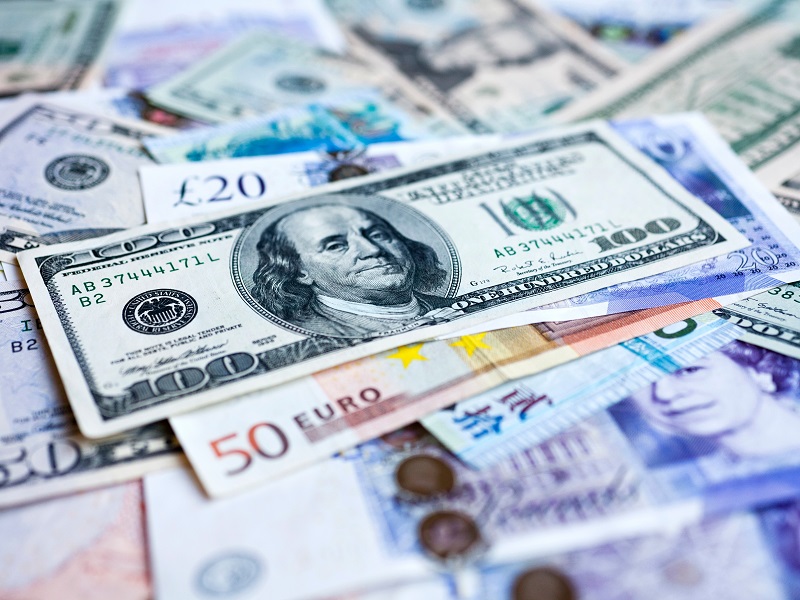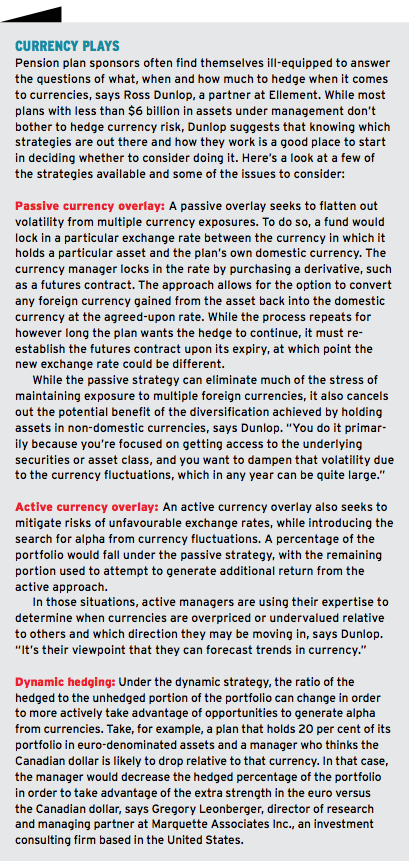
The Canadian dollar has had its share of ups and downs over the past year or so. At the beginning of 2017, it sat at 74 cents U.S., rising to a recent high of 82 cents in September. Since then, it has fluctuated at around the 80-cent level, falling by a few cents throughout early March.
The dollar’s rise can have a negative material impact on pension plans’ returns on their foreign holdings. In November, for example, the Canada Pension Plan Investment Board cited the Canadian dollar’s 6.6 per cent rise over the prior six months against the U.S. currency as a factor in its modest return of 0.7 per cent in the second quarter of its 2018 fiscal year.
Read: How is the Canadian dollar’s rise affecting pension plans?
Given the volatility, what are the most important factors for Canada’s pension plans to watch for in the coming year and how can they use currency levers to enhance and protect returns?
Trade issues
Trade protectionism is likely to be one of the year’s most significant market movers, especially for currencies, says Scott DiMaggio, co-head of fixed income at AllianceBernstein.
With the North American Free Trade Agreement under fire from U.S. President Donald Trump’s administration, institutional investors are watching to see how aggressive he’ll be on the issue, says DiMaggio. “Depending on how this goes, in our estimation, the Canadian dollar looks a tad expensive, and the Mexican peso looks cheap from a fair-value perspective,” he says.
Read: Investors challenged by ups and downs of NAFTA talks
Arnab Nilim, portfolio manager on the currency strategies team in the global fixed-income group at AllianceBernstein, explains the issue further. “If you look at the currency market performance heading into the Trump election . . . the Mexican peso underperformed the most. The Canadian dollar didn’t get any such negative performance on that,” he says, noting there’s potential for further downward pressure on the Canadian dollar if the NAFTA talks continue to look unfavourable for Canada.
For smaller defined benefit pension plans, NAFTA will be a key point to watch this year, notes Lesley Gallinger, chief financial officer for the Electrical Safety Authority, an Ontario-based administrative authority. “Anything that smacks of protectionism and softens global trade views is going to impact us from a currency perspective,” she says.
Plans like the Electrical Safety Authority’s, with an approximate size of $350 million in assets, hold large amounts of non-Canadian equity. Canadian plans with less than $1 billion in assets under management held an average of 20.9 per cent in U.S. equities, according to the Canadian Institutional Investment Network. “Global equity, [including U.S.], is actually our highest single allocation,” says Gallinger.
While the Canadian dollar will likely be more volatile in light of NAFTA negotiations and trade issues more generally, François Bourdon, global chief investment officer at Fiera Capital Corp., says they likely won’t send the loonie careening off in any particular direction. Issues with NAFTA are “going to take a little bit longer,” he says, suggesting the questions around the trade deal will mean continued volatility for the Canadian dollar but won’t ultimately affect the currency’s long-term movement.
Read: 2017 Top 40 Money Managers Report: Investing in the age of Donald Trump
Rather than a broad rewrite of the trade agreement, the United States will more likely subject Canada to targeted trade actions, says Tim Alt, director of rates and currencies at Aviva Investors.
“The expectation we have this year is that there will be some tariffs implemented around the industries and sectors that are more sensitive to [U.S.] national security, so steel and things of that nature, energy. We’ve seen the tariffs on solar,” says Alt. Trump, of course, moved on steel tariffs in March but exempted Canada and Mexico temporarily.
Money in the bank
Currency fluctuations will also have a lot to do with the ongoing renormalization of global monetary policy, with the Bank of Canada and the U.S. Federal Reserve both forecasting further rate hikes this year and the European Central Bank and the Bank of Japan hinting at similar actions, says David Tulk, an institutional portfolio manager at Fidelity Investments.
The simultaneous edging away from easy monetary policy “is certainly something that could introduce a lot more volatility into currencies this year,” he says.
Both the European Central Bank and Bank of Japan have yet to take any actions on raising rates, but 2018 should be the year when they bring their quantitative easing programs to a gentle halt, says DiMaggio.
Read: What’s the outlook for key Asian economies?
Not every central bank is raising rates, however. In 2017, India, Brazil, Chile, Australia and South Africa all lowered them, for example. While investors traditionally assume lower interest rates will boost equities, what can be positive news for that asset class often has a negative impact on currencies, especially in developed markets, says DiMaggio. “We’ve found that when countries are cutting interest rates, that tends to be bad for the currency. While you may be making a very good stock decision in buying foreign stocks, you may lose if you’re not monitoring that currency exposure,” he says.
For less liquid, longer-term assets, however, that’s less of a concern, he adds. “Currencies, in the long term, revert to fair value.”
To hedge or not to hedge
Regardless of what may be influencing them, currency fluctuations are never something pensions plans can afford to ignore, says Nilim. “You can be the best stock picker and the best bond picker, but if you don’t manage currency, you can actually end up having negative performance. So you have to . . . manage it,” he says.
However, building currency considerations into the portfolio depends heavily on the mandate of a given pension fund, says Alt.
Most plans should probably take hedging practices into consideration, says Bourdon, who estimates 60 per cent of pension funds in Canada have more than 20 per cent foreign exposure. “Those funds with less exposure don’t necessarily require a formal hedging strategy,” he says.
Read: Why dynamic hedging is a good option for managing currency risk
“You may have views, and you may want to express those views, but from a long-term positioning standpoint, I think anything under 20 per cent is not a cause of worry,” says Bourdon. “As you move higher in terms of exposure, then you need to really take that into account and implement an active program to try to make money out of currencies or reduce your exposure to foreign currencies.”
Even measuring that level of exposure has become more difficult in recent years, Gallinger points out. The international nature of modern business means purchasing a single U.S. equity gives a plan exposure not only to the U.S. dollar but possibly to other currencies as well.
For example, 3M Co. receives only about 40 per cent of its revenue from the United States, says Arthur Heinmaa, chief executive officer of Cidel Asset Management Inc. The remaining 60 per cent is revenue from a wide range of other countries.
Even without hedging directly, currency should still play a part in the timing of asset acquisitions, says Lewis Powell, a consultant at Proteus Performance Management. “If you’re trying to make a new allocation outside of Canada, you are taking a lot of timing risk for sure, if you’re pulling the trigger on any given day.”
Another timing consideration relates to capital calls, when plans investing in foreign real assets or larger pooled funds require cash to fill a call in a foreign currency at a specific time, says Powell.
“A lot of the vehicles to access these asset classes have queues and lineups, so you need to work through the queue and as your assets get called, you need to provide it as per the contract you signed,” says Powell. “So the currency will be whatever it is at that time.”
Read: Sovereign investors making fewer allocation changes: study
He notes, however, that if an institutional investor is very confident about a currency’s direction, it can invest in it directly. “It doesn’t need to be a byproduct of foreign assets; you can just go and trade currencies and try to provide returns,” says Powell, adding he doesn’t know of any pension fund with less than $1 billion in assets that views currencies as a separate asset class that it can use to enhance returns.
Indeed, trading currencies directly has become less popular among pension funds since the 2008 financial crisis, says Alt. “If I think back to the 2007 appetite, there was a lot more interest in investing currencies as a standalone asset class, if you will. And by default, that meant less hedging out the currency risk and more living with currency risk as a way to enhance returns.”
Even after moving on from the crisis period, Canadian pension funds don’t seem to have picked the habit back up, he adds. “I think that’s a reflection of the fact that currencies are somewhat more complicated. . . . When I’m investing in a currency, I need to know the fundamentals of a single country but also the fundamentals of the counter country with the counter currency, depending on what the currency pair is that you’re investing in. And not only that, you also have to take into account where we are in the global risk cycle relative to each other and where economies and global banks are to one another,” says Alt.
Gallinger says she has seen larger funds with active currency strategies post less impressive returns than her organization’s pension plan, which uses no specific currency overlay. “It’s different for every plan, and it’s different for every risk profile, obviously. So for us, it’s really just making sure you diversify and making sure you understand where the managers have made larger bets and keeping abreast of those,” she says.
Martha Porado is an associate editor at Benefits Canada.
